Over recent years, artificial intelligence has undergone many changes, many of which are supported by machine learning and deep learning. One of the most groundbreaking advancements in this arena is the Generative Pre-trained Transformer or GPT. Originally created by OpenAI, GPT has quickly risen to the ranks and challenged the status quo of current AI techniques in natural language processing and generation.
The Genesis of GPT
As with GPT, the journey started with the main idea of developing a model that can both encode and generate human text. Earlier NLP models for specific tasks were trained on large datasets for the specific task to be performed, and this was time-consuming. GPT, however, introduced a paradigm shift with its two-stage approach, and pre-training and fine-tuning are two of them.
During the pre-training phase, the model is acquired with the knowledge of grammar, facts about the world, and some amount of reasoning. Transfer learning follows this by customizing the broad pre-trained model for specific tasks using more relevant datasets.
Applications and Impact
Due to its flexibility of use, GPT has been adopted by different fields, thus becoming the center of many aspects of diverse fields. When it comes to content creation, GPT can write articles, short or long stories, and even poems, which is a great help to writers and creative individuals. Its capability to generate human-like text has also been employed in customer relations through the use of chatbots/ virtual assistants, which help in offering immediate responses to user inquiries.
For the Domain of Education GPT is used to facilitate individual learning. It can produce sample questions for practice and teach students of different levels in various courses. The health sector has also been enriched, and GPT proves useful when preparing and editing medical reports, brief histories of patients, initial diagnosis based on patients’ complaints about their health. For more detailed information on how GPT is transforming these fields, Please follow the link. GPT’s growth remains progressive, and new problems are solved with the help of this approach in various fields. Its uses revolutionalize industries and enhance results in ways that have not been witnessed before.
Architecture and Functionality
The framework used by GPT is based on the transformer model that employs a structure called attention to determine the relevance of words in a given sentence. In contrast to RNNs that operate sequentially, transformers foresee the entire sequence eliminating the potential for inefficiency and, therefore, increasing their effectiveness. Honestly, the attention mechanism facilitates the model to capture the context and relations between different words, and it can consequently create correspondingly smooth and meaningful text.
The key innovation in GPT is self-attention and multi-head attention algorithms. These allow the model to work with many facets of the input at once, thus gaining better insights into the language. Also, positional encodings are used at GPT to track the order of the words so that the generated text is grammatically and logically correct.
Ethical Considerations and Challenges
As groundbreaking as it is, GPT has several ethical and functional issues. The conflicts of interest could precipitate the widespread abuse of online consultation services. A highly convincing type of text can be produced and used to make deep fakes and disinformation and even perform phishing. Over time, the technology enhances, and the differentiation of automatically generated content from the original human-generated one remains restless, thereby posing considerable threats to the correct dissemination of information.
The other drawback is that, due to the model itself, content that is partly biased or, at least, not quite appropriate can be produced. This is because GPT adapts to huge datasets encompassing virtually all kinds of text produced by humans. Therefore, it can mimic and even exacerbate prevailing biases in the data. This can result in the creation of bias or technically overtly racist material thus the importance of potent procedures to detect and eradicate bias in AI systems.
The Future of GPT
Regarding the future perspectives of such models as GPT, one can speak about their both bright and rather challenging development. Subsequent future developments in models’ structure, training algorithms, and data selection and preparation should improve the GPT performance in recognizing and generating human language. There are also efforts expressed to enhance the interpretability of such models so that one can understand how the model is making its decisions and producing its outputs.
Working effectively with these technologies will involve the contributions of AI operators, ethical theorists, legislators, and society members on GPT. Setting and enforcing the rules and legislations on the utilization of the generative AI, being clear on the model designing, and promoting the usage of AI ethically go a long way in optimizing for the technology and deoptimizing for the vices it brings about.
Conclusion
The Generative Pre-trained Transformer can be said to be the biggest advancement in artificial intelligence to date. Its feature of generating human-like text has brought opportunities in multiple fields, breaking the limitation of people’s interaction with the machines. But, being a potent tool and a powerful resource, GPT has also its ethical social and environmental consequences. Thus, while moving forward in the development of this revolutionary technology the society should learn how to properly integrate them to have the beneficial impact which GPT shows the potential of.

